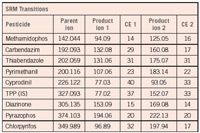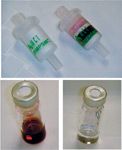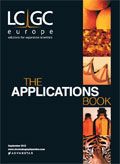Determination of Pesticide Residues in Red Wine by QuEChERS Extraction, Quick QuEChERS Cleanup and LC–MS-MS Detection
UCT
Red wine is a challenging matrix that contains organic acids, sugars, phenols and pigments such as anthocyanins. This application note describes a simple, fast, novel and effective method to clean up red wine co-extractives.

Extraction Procedure
a) Add 10 mL red wine to 50 mL tube (RFV0050CT)
b) Add 10 mL acetonitrile, vortex 30 s
c) Add salts from Mylar pouch (ECQUUS2-MP)
d) Shake vigorously for 1 min
e) Centrifuge at 5000 rpm for 5 min
f) Supernatant is ready for cleanup
Quick QuEChERS Cleanup
a) Load 1 mL supernatant with disposable syringe
b) Push the supernatant slowly through the cartridge (ECPURMPSMC)
c) Collect 0.5 mL extract into 2 mL autosampler vial
d) Add triphenyl phosphate as internal standard
LC–MS-MS Instrumentation
LC: Thermo Accela 1250 pump
- Column: SepaxHP-C18, 2.1 × 100 mm, 3 µm, 120 Å
- Guard: Restek C18 2.1 × 20 mm, 3 µm
- Column temperature: Ambient
- Injection: 10 µL at 15° C
- Mobile phase: A: 0.1% formic acid in water; B: 0.1% formic acid in methanol
- Gradient: 0 min: 95% A; 1 min: 95%; 3 min: 50% A; 8 min: 5% A; 14 min: 5% A; 14.2 min: 95% A; 16 min: 95% A
- Flow rate: 200 µL/min

MS-MS: Thermo TSQ Vantage
- Ion source: Heated ESI positive, 350 ºC
- Spray voltage: 3000 V
- Sheath gas: N2 at 40 psi
- Auxiliary gas: N2 at 10 psi
- Collision gas: Ar at 1.5 mTorr
Results:
Recoveries ranged from 81.6 to 112.2% with RSD less than 10.8% achieved for red wine samples fortified with 10, 50 and 100 ng/mL pesticides.

Figure 1: Top: Quick QuEChERS cartridges before and after cleanup of 1 mL red wine extract; Bottom: Red wine extract before (left) and after (right) Quick QuEChERS cleanup.
UCT, LLC
2731 Bartram Road, Bristol, Pennsylvania 19007, USA
tel. 800.385.3152
Email: methods@unitedchem.com
Website: www.unitedchem.com

Analytical Challenges in Measuring Migration from Food Contact Materials
November 2nd 2015Food contact materials contain low molecular weight additives and processing aids which can migrate into foods leading to trace levels of contamination. Food safety is ensured through regulations, comprising compositional controls and migration limits, which present a significant analytical challenge to the food industry to ensure compliance and demonstrate due diligence. Of the various analytical approaches, LC-MS/MS has proved to be an essential tool in monitoring migration of target compounds into foods, and more sophisticated approaches such as LC-high resolution MS (Orbitrap) are being increasingly used for untargeted analysis to monitor non-intentionally added substances. This podcast will provide an overview to this area, illustrated with various applications showing current approaches being employed.

















